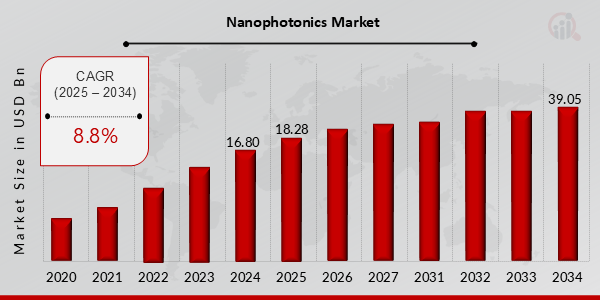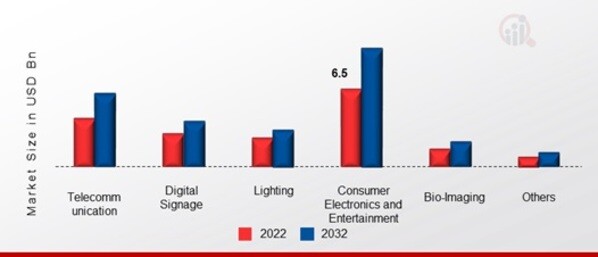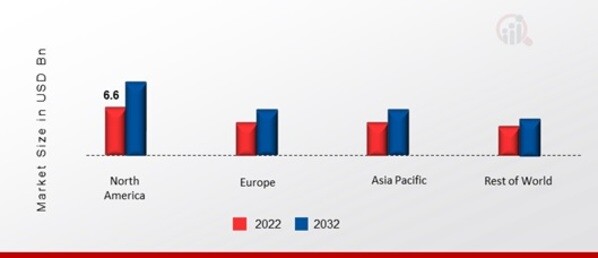Global Nanophotonics Market Overview
Nanophotonics Market Size was valued at USD 16.80 Billion in 2024. The nanophotonics market industry is projected to grow from USD 18.28 Billion in 2025 to USD 39.05 Billion by 2034, exhibiting a compound annual growth rate (CAGR) of 8.8% during the forecast period (2025-2034). The market is expected to grow in revenue due to a number of market drivers, including the growing demand for energy-efficient products, the need for optical components to be smaller, the growing applications in various industries like solar power, defense, and telecommunication, as well as the growing need for biosensing and optical imaging in healthcare.

Source: Secondary Research, Primary Research, MRFR Database and Analyst Review
Nanophotonics Market Trends
Rising demand for various communication technologies is driving the market growth
The market for nanophotonics is expanding due to the rising demand for various communication technologies, such as optical fibers. Innovative and cutting-edge characteristics including enhanced sensing, refractive index, and computation have been made possible by the addition of nanoparticles to optical fibers. In contrast to the National Broadband Mission's objective of deploying 50 lakh kilometers of optical fiber by 2024, India's optical fiber-based network has reached 28 lakh (100,000) kilometers, according to IEEE, a professional association for electronic and electrical engineering. Hence, there is still room for the nation to add more optical fiber as its population grows.
Therefore, the need for optical fiber will propel the market for nanophotonics to rise.
The broad acceptance of nanophotonics for applications in electronic engineering, communication, biotechnology, defense, and solar power conversion is the primary driver of the worldwide nanophotonics market. The growing market is also being driven by the growing use of LEDs in consumer gadgets. Solid-state lighting with high thermal conductivity and variable rate is provided by nanophotonics, enhancing the methods' operational efficacy and the quality of the light emitted. In addition, manufacturers of nanophotonic devices are combining transistors and small-scale power circuits onto a single chip to achieve higher bandwidth and faster data transfer rates.
This makes it possible for nanophotonic integrated circuits (ICs) to establish direct light-based connections with other devices.
Novel goods enabled by nanophotonics are a major trend that is becoming more and more well-liked in the nanophotonic industry. In the last several years, there has been a rise in demand for products with nanophotonic capabilities. Products with nanophotonic capabilities include OLEDs, LES, and others. Moreover, optical diagnostics, nanomedicine, and biotechnology employ these goods with nanophotonic capabilities. For instance, American privately held optical equipment manufacturer Thorlabs Inc. announced in January 2021 the launching of the SPDC810 product line, which is anticipated to serve the quickly growing quantum photonics market.
High intensity photon sources are essential to quantum photonics for several purposes such as basic photon-matter interactions and device characterisation. A completely integrated and controllable 405 nm pump source is used at the front end of a spontaneous parametric down conversion (SPDC) device by designers to generate photon pairs over 450 kHz at 810 nm. Thus, driving the nanophotonics market revenue.
Nanophotonics Market Segment Insights
Nanophotonics Product Types Insights
The Nanophotonics Market segmentation, based on product types includes LED, OLED, Near Field Optics, Photovoltaic Cells, Optical Amplifiers, Optical Switches, and Others. The LED segment dominated the market. The broad range of uses for LEDs with high intensity. In the nanophotonics LED market, the UV LED and high-beam LED hold the two highest market shares, respectively.
According to the business, some of the major application areas for these components include artificial photosynthesis, medical technology, UV healing, traffic signaling, illumination, and counterfeit detection. They are also used in backlighting in electronic displays.
Nanophotonics Material Insights
The Nanophotonics Market segmentation, based on material, includes Plasmonics, Photonic Crystals, Nanotubes, Nanoribbons, Quantum Dots, and Others. The quantum dots category generated the most income. Small semiconductor particles called quantum dots (QDs) have unique optical and electrical characteristics from larger particles. They are only a few nanometers in size. In nanotechnology, they are highly significant. An electron within a quantum dot may be stimulated to a higher energy level when exposed to UV radiation.
Nanophotonics End Use Insights
The Nanophotonics Market segmentation, based on end use, includes Telecommunication, Consumer Electronics and Entertainment, Digital Signage, Lighting, Bio-Imaging, and Others. The consumer electronics and entertainment category generated the most income due to the growing need for photonic integrated circuits with high switching speeds in signal processing applications. For almost ten years, the electronics industry has seen a trend toward smaller components and their integration.
Due to the development and widespread usage of smartphones, the demand to achieve superior efficiency from the tiniest devices has acquired more stimulation and supplied momentum to the global nanophotonic market.
Figure 1: Nanophotonics Market, by End Use, 2022 & 2032 (USD Billion)

Source: Secondary Research, Primary Research, MRFR Database and Analyst Review
Nanophotonics Regional Insights
By region, the study provides the market insights into North America, Europe, Asia-Pacific and Rest of the World. The North American nanophotonics market area will dominate this market. Due to rising investment in end-use industries such consumer electronics, solar power conversion systems, and telecommunications, the United States is driving growth in the regional market. The increasing popularity of smart offices and homes due to technological advancements is driving up demand for consumer electronics like smart refrigerators, air conditioners, TVs, and more.
Furthermore, the industry is expanding more quickly due to consumers' increased disposable money and their evolving tastes for smart homes and workplaces.
Further, the major countries studied in the market report are The US, Canada, German, France, the UK, Italy, Spain, China, Japan, India, Australia, South Korea, and Brazil.
Figure 2: NANOPHOTONICS MARKET SHARE BY REGION 2022 (USD Billion)

Source: Secondary Research, Primary Research, MRFR Database and Analyst Review
Europe nanophotonics market accounts for the second-largest market share Because there is a large consumer base for nanophotonic devices in Europe, the market is growing at the quickest rate. Additionally, as more and more nanophotonic application areas emerge, the European Market gains from substantial investment in R&D. Further, the German nanophotonics market held the largest market share, and the UK nanophotonics market was the fastest growing market in the European region
The Asia-Pacific Nanophotonics Market is expected to grow at the fastest CAGR from 2023 to 2032. The market for nanophotonic equipment is flourishing as a result of significant advancements in the healthcare, consumer electronics, and automotive sectors. India, China, and Japan are in the forefront of the market due to their remarkable industrial development. Moreover, China’s nanophotonics market held the largest market share, and the Indian nanophotonics market was the fastest growing market in the Asia-Pacific region.
Nanophotonics Key Market Players & Competitive Insights
Leading market players are investing heavily in research and development in order to expand their product lines, which will help the nanophotonics market, grow even more. Market participants are also undertaking a variety of strategic activities to expand their global footprint, with important market developments including new product launches, contractual agreements, mergers and acquisitions, higher investments, and collaboration with other organizations. To expand and survive in a more competitive and rising market climate, nanophotonics industry must offer cost-effective items.
Manufacturing locally to minimize operational costs is one of the key business tactics used by manufacturers in the global nanophotonics industry to benefit clients and increase the market sector. In recent years, the nanophotonics industry has offered some of the most significant advantages to medicine. Major players in the nanophotonics market are attempting to increase market demand by investing in research and development operations includes
Technology company Schott AG (Schott) is a division of Carl Zeiss Stiftung AG. It creates, produces, and sells glass-ceramics and specialty glass materials. The company provides a large range of systems, components, exotic glass, and specialty materials. Advanced optics, pharmaceutical systems, electronic packaging goods, lighting and imaging solutions, and flat glass are just a few of the products in its portfolio.
Semiconductors are made and supplied by STMicroelectronics NV (STM). The company designs and sells a broad range of products, including as application-specific standard and integrated circuits, custom and semi-custom devices, and discrete and standard commodity components. In addition, it manufactures and distributes silicon chips, smartcards, switches, clocks, power modules, data converters, automotive ADAS devices, and image and photonics systems.
Key Companies in the nanophotonics market include
- Novaled GmbH (Samsung SDI Co.)
- OSRAM Opto Semiconductors GmbH
- WITec Wissenschaftliche Instrumente und Technologie GmbH
Nanophotonics Industry Developments
October 2022: In Erice, Italy, the workshop Foremost Photonics 2022 was held at the Ettore Majorana Foundation and Center for Scientific Culture. The association for Nanophotonics Europe (NEA) was in charge of organizing it. Prominent nanophotonics figures shared their thoughts on the future of the subject at the gathering. They also talked about the actions that ought to be done to advance the careers of aspiring researchers.
March 2021: The inspection system known as "MiNYTM PL micro-LED PL" was developed by Hamamatsu Photonics. At 100% speed, this inspection device can examine micro-LEDs for next-generation displays. The newly constructed display is employed to detect anomalies in their external characteristics, intensity of light emission, and wavelength. Utilizing the MiNYTM PL micro-LED PL inspection technology, quick pass/fail decisions are rendered. Better micro-LED R&D efficiency and higher product yield for display applications are brought about by this new invention.
Nanophotonics Market Segmentation
Nanophotonics Product Types Outlook (USD Billion, 2018-2032)
Nanophotonics Material Outlook (USD Billion, 2018-2032)
Nanophotonics End Use Outlook (USD Billion, 2018-2032)
- Consumer Electronics and Entertainment
Nanophotonics Regional Outlook (USD Billion, 2018-2032)
| Report Attribute/Metric |
Details |
| Market Size 2024 |
USD 16.80 Billion |
| Market Size 2025 |
USD 18.28 Billion |
| Market Size 2034 |
USD 39.05 Billion |
| Compound Annual Growth Rate (CAGR) |
8.8% (2025-2034) |
| Base Year |
2024 |
| Market Forecast Period |
2025-2034 |
| Historical Data |
2020- 2023 |
| Market Forecast Units |
Value (USD Billion) |
| Report Coverage |
Revenue Forecast, Market Competitive Landscape, Growth Factors, and Trends |
| Segments Covered |
Product Types, Material, End Use, and Region |
| Geographies Covered |
North America, Europe, Asia Pacific, and the Rest of the World |
| Countries Covered |
The US, Canada, German, France, UK, Italy, Spain, China, Japan, India, Australia, South Korea, and Brazil |
| Key Companies Profiled |
Anders Electronics PLC, Cree Inc., Nanosys Inc., Novaled GmbH (Samsung SDI Co.), OSRAM Opto Semiconductors GmbH, Lumileds Holding B.V., Schott AG, Sharp Corporation, STMicroelectronics N.V., Veeco Instruments Inc. and WITec Wissenschaftliche Instrumente und Technologie GmbH |
| Key Market Opportunities |
· Expanding technological innovations to increase market share |
| Key Market Dynamics |
· Consumer electronics demand is expected to rise, driving market expansion · Expanding the usage of LEDs to drive industry expansion |
Frequently Asked Questions (FAQ):
The Nanophotonics Market size was valued at USD 16.80 Billion in 2024.
The global market is projected to grow at a CAGR of 8.8% during the forecast period, 2025-2034.
North America had the largest share in the global market
The key players in the market are Anders Electronics PLC, Cree Inc., Nanosys Inc., Novaled GmbH (Samsung SDI Co.), OSRAM Opto Semiconductors GmbH, Lumileds Holding B.V., Schott AG, Sharp Corporation, STMicroelectronics N.V., Veeco Instruments Inc. and WITec Wissenschaftliche Instrumente und Technologie GmbH.
The LED category dominated the market in 2022.
The consumer electronics and entertainment category had the largest share in the global market.

















